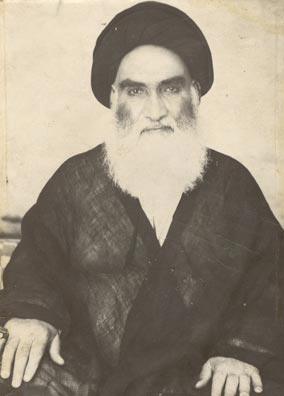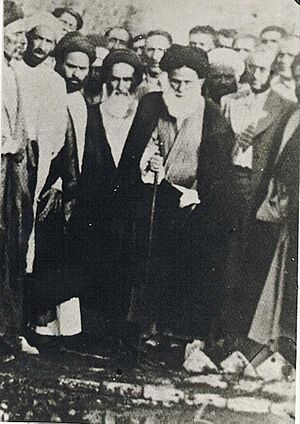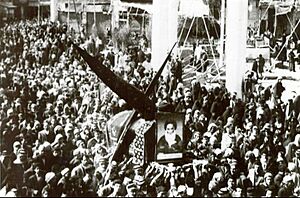Mirza Mahdi al-Shirazi facts for kids
Quick facts for kids Grand Ayatollah Sayyid Mirza Mahdi al-Shirazi |
|
|---|---|
| الميرزا مهدي الحسيني الشيرازي | |
 |
|
| Religion | Islam |
| Personal | |
| Born | May 8, 1887 Karbala, Baghdad Vilayet, Ottoman Empire |
| Died | February 14, 1961 (aged 73) Karbala, Republic of Iraq |
| Resting place | Imam Husayn Shrine |
| Children |
|
| Parents | Habiballah al-Shirazi (father) |
| Relatives | Mirza Shirazi (great uncle) Mirza Taqi al-Shirazi (maternal uncle) Abd al-Hadi al-Shirazi (second cousin, once removed & brother-in-law) Razi Shirazi (second cousin, once removed) Mohammed Ridha al-Shirazi (grandson) Hussein al-Shirazi(grandson) Mohammad Taqi al-Modarresi (grandson) Hadi al-Modarresi (grandson) Ali Akbar al-Modarresi (grandson) |
| Senior posting | |
| Based in | Karbala, Iraq |
| Period in office | 1949–1961 |
| Predecessor | Hossein Tabatabaei Qomi |
| Successor | Muhsin al-Hakim (leadership centralized in Najaf) |
Grand Ayatollah Mirza Mahdi al-Husayni al-Shirazi (born May 9, 1887 – died February 14, 1961) was an important Shia religious leader, known as a Marja' (a top religious authority). He was from Iraq and Iran. After other senior leaders passed away, Mirza Mahdi became the most respected religious scholar in Karbala, Iraq. He was also one of the top leaders in all of Iraq, alongside other important figures like Muhsin al-Hakim.
Mirza Mahdi was also the Imam (leader) of the Imam Husayn Shrine, a very holy place for Shia Muslims.
Contents
Biography
Early Life and Studies
Mirza Mahdi was born in Karbala, a city in Iraq, into a well-known religious family called the Shirazi family. His father was Mirza Habibullah al-Shirazi. He was the fourth of eight children. His older brother, Abdullah al-Shirazi, and younger brother, Jafar al-Shirazi, also became religious scholars.
He started his religious education when he was very young in Karbala. He learned from his brother, Abdullah, and other teachers. After his father died in 1902, he moved to Najaf, another important city for religious studies, to learn from famous scholars like Akhund Khurasani. Later, he went to Samarra with his family to study at its religious school, which was led by his uncle, Mirza Muhammad-Taqi al-Shirazi.
During a difficult time called the siege of Kut, Mirza Mahdi and his uncle moved to Kadhimiya for safety. They lived there for about a year and a half, facing many challenges. Then, they returned to Karbala. His uncle, Mirza Taqi, was getting ready to lead the Iraqi revolt of 1920 against the British. Mirza Mahdi supported his uncle in this revolt. Sadly, his uncle passed away in 1920. After this, Mirza Mahdi went back to Najaf to continue his religious studies with new teachers.
Return to Karbala
In 1935, a senior religious leader named Hossein Tabatabaei Qomi was forced to leave Iran. He moved to Karbala and asked Mirza Mahdi to return there to help him restart and strengthen the religious school in the city. Mirza Mahdi agreed and moved back to his hometown.
After Hossein Qomi passed away in 1947, Mirza Mahdi became the main leader of the religious school in Karbala. He was seen as the most senior religious judge there. This position became even stronger after another important scholar, Muhammad-Hadi al-Khurasani, died in 1949.
Leading the Karbala Seminary
Under Mirza Mahdi's leadership, the religious school (called a hawza) in Karbala grew a lot. He introduced new ways of teaching religious studies, which made many young people want to join the school. He taught many students who later became important scholars themselves.
During his time as head, new religious events were started. For example, a famous reading of the story of Maqtal al-Husayn was performed for the first time in the shrine of Imam Husayn in 1959. This reading was done by his student, Sheikh Abd al-Zahra al-Ka'bi.
Standing for Unity
In 1958, the government in Iraq was focusing on Arab identity, which made things difficult for the Iranian community in Karbala. Mirza Mahdi, who was active in this community, wrote a letter to the governor of Karbala to complain about how Iranians were being treated. The governor got angry and said Mirza Mahdi had no right to interfere because he was Iranian.
Mirza Mahdi replied, reminding the governor that it was people like them who started the 1920 revolt, which helped Iraq gain more freedom from the British. He told the governor that if he didn't want to work with their demands, he could leave the city.
After this, Mirza Mahdi developed a new idea. He believed that holding an "Iraqi citizenship" was a new idea created by powerful countries to divide Muslims. He felt it went against human freedom and religious law, and that it created barriers between people. He also thought it was a way for the ruling government to control the Shia community.
Standing Against Communism
After a big change in government in Iraq in 1958, a new leader allowed communism to become very popular. For a while, Iraq became a place of protests where people who supported communism attacked the homes of religious leaders and others. It was a very difficult time for religious people.
In Karbala, a protest was planned by communist leaders. They had a list of people they wanted to attack, including Mirza Mahdi's son, Muhammad. These people were targeted because they were seen as being against communism.
At this point, the top religious leaders decided to act. Mirza Mahdi, Muhsin al-Hakim, and Abu al-Qasim al-Khoei met at Mirza Mahdi's home in Karbala. They decided to issue religious rulings, called fatwas, saying that the Iraqi Communist Party was against Islamic beliefs. They also started working together to stop the spread of communist ideas. Many believe these actions helped to end the influence of communism in Iraq.
Mirza Mahdi issued several fatwas that said it was wrong to support the Communist party. He even said that a true Muslim should not buy meat from a butcher who was a communist.
Personal Life
Mirza Mahdi was married to Halima al-Shirazi. They had ten children: four sons (Muhammad, Hassan, Sadiq, and Mujtaba) and six daughters. Some of his daughters married into other respected religious families.
Works
Books
Mirza Mahdi wrote many books. Some of his most important ones include:
- Sharh al-Urwat al-Wuthqa (Explaining The Firmest Bond)
- Thakhirat al-Ibad (The Worshippers' Provisions)
- Manasek al-Haj (Hajj Rituals)
- Kashkool Fi Mukhtalaf al-'Uloom (An Assortment in Different Sciences)
Poetry
Mirza Mahdi also wrote beautiful poetry, often praising the Ahl al-Bayt (the family of Prophet Muhammad). One of his most famous poems was written for the birthday of Fatimah, which starts with these lines:
|
درّة أشرقت بأبهى سناها |
A pearl has risen with prestigious light, |
Death
Mirza Mahdi passed away on the evening of Tuesday, February 14, 1961, just as he was getting ready for the Maghrib (sunset) prayer. The next day, as his body was being prepared for burial, there was a partial solar eclipse. The city of Karbala became dark for almost an hour, as 67% of the sun was covered. People in the city rushed to pray the special Ayat prayer for the eclipse before continuing with the funeral. He was buried in the southeastern part of the Imam Husayn Shrine.
His death deeply affected the Shia Muslim world. It is said that Hossein Borujerdi, another very important religious leader in Qom, Iran, cried for several minutes when he heard the news of Mirza Mahdi's passing.
Images for kids






